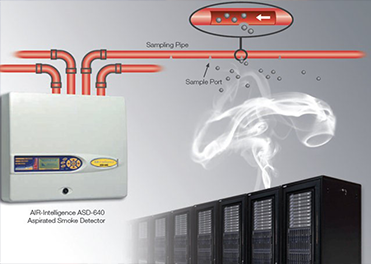Unveiling the Technology Behind Air Sampling Smoke Detection Systems

In the realm of fire safety, the evolution of detection technology has reached new heights with the advent of Air Sampling Smoke Detectors. Unlike traditional spot-type detectors that passively monitor their immediate surroundings, air sampling detectors take a proactive approach by actively drawing room air through a network of pipes or tubing to their detection chamber. This allows them to identify the presence of particles created in the early stages of combustion, often before visible smoke emerges.
- How Air Sampling Smoke Detectors Work
At the core of an Air Sampling Smoke Detection system is a distribution network comprising pipes or tubing running from the detector to the targeted protection areas. Within the detector housing, an aspiration fan draws air from the protected zone back to the detector through air sampling ports, tubing, or piping. The detector then analyzes this air for the presence of fire products. This active sampling method sets air sampling detectors apart, enabling them to detect fires at their earliest stages.
Types of Air Sampling Systems
1. LASER SYSTEMS – FILTERED
In this type, a fan continuously draws air into a pipe network attached to a detector unit. The air passes through a dual-stage filter, removing particles larger than 25 microns. Clean air then enters a laser detection chamber for smoke detection. The detector measures light scatter caused by smoke, presenting the smoke level graphically.
2. LASER SYSTEMS – PARTICLE COUNTING
This system employs a fan to draw air through the detection chamber. As particles pass through a laser beam, a photo collector measures reflected light, counting discrete particles to determine smoke concentration. Unlike filtered systems, particle counting distinguishes particles of combustion from dust and other contaminants, reducing nuisance alarms.
3. CLOUD CHAMBER SYSTEMS
The oldest technology among air sampling systems, Cloud Chamber Systems, uses water. By humidifying a sample of air and exposing it to rapid expansion, particulate matter acts as seeds, forming microscopic water droplets. This amplifies the size of particulate matter, making it easily detectable. However, maintaining this system poses challenges, including water replacement and mechanical failures.
While Cloud Chamber Systems were effective in their time, laser-based technologies now offer significant advantages. Laser systems require less maintenance, have fewer moving parts, and can distinguish between particles more accurately.
Advantages of Air Sampling Smoke Detectors
1. Early Detection: Identifying fires in their infancy, air sampling detectors provide crucial time for timely response and intervention.
2. Adaptability: These detectors thrive in diverse environments, offering reliable performance in areas with challenging conditions such as high ceilings or extreme temperatures.
3. Reduced False Alarms: By customizing sensitivity levels and employing advanced particle counting techniques, air sampling detectors significantly reduce false alarms compared to traditional spot detectors.
4. Technological Evolution: Laser-based systems represent a leap forward in detection technology, providing more accurate and reliable results.
- (This "Fire Safety Blogs" Published in January 2024 Edition)












